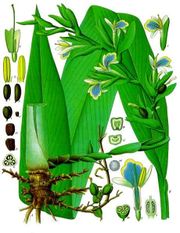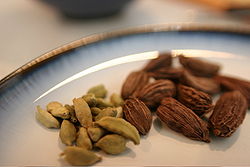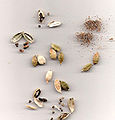Cardamom
| Cardamom | |
|---|---|
 |
|
| True Cardamom (Elettaria cardamomum) | |
| Scientific classification | |
| Kingdom: | Plantae |
| (unranked): | Angiosperms |
| (unranked): | Monocots |
| (unranked): | Commelinids |
| Order: | Zingiberales |
| Family: | Zingiberaceae |
| Genera | |
|
|
Cardamom refers to several plants of the genera Elettaria and Amomum in the ginger family Zingiberaceae. Both genera are native to India, they are recognised by their small seedpod, triangular in cross-section and spindle-shaped, with a thin papery outer shell and small black seeds. Elettaria pods are light green while Amomum pods are larger and dark brown. The word cardamom is derived from the Latin "cardamomum",[1] the romanization of the Greek "καρδάμωμον" (kardamomon),[2] in turn from "κάρδαμον" (kardamon), "cress"[3] + "ἄμωμον" (amomon), a kind of an Indian spice plant.[4] The earliest attested form of the word kardamon is the Mycenaean Greek ka-da-mi-ja, written in Linear B syllabic script.[5]
Contents |
Types and distribution
The two main genera of the ginger family that are named as forms of cardamom are distributed as follows:
- Elettaria (commonly called cardamom, green cardamom, or true cardamom) is distributed from India to Malaysia.
- Amomum (commonly known as black cardamom (沙仁), brown cardamom, Kravan, Java cardamom, Bengal cardamom, Siamese cardamom, white cardamom, or red cardamom) is distributed mainly in Asia and Australia.
The Sanskrit name for cardamom is "elā" or "truṭī." In Urdu/Hindi/Gujarati and some Southern Indian languages, it is called "ilaayachee" or "elchi." In Nepali, it is "Alaichii". In Marathi, it is "Velchi" or "Veldodaa". In Malayalam, it is "Aelam". In Telugu & Tamil, it is "elakkai" and in Kannada it is "yelakki".
Varieties
There were initially three natural varieties of cardamom plants.
- Malabar (Nadan/Native) - As the name suggests, this is the native variety of Kerala. These plants have panicles which grow horizontally along the ground.
- Mysore - As the name suggests, this is a native variety of Karnataka. These plants have panicles which grow vertically upwards.
- Vazhuka - This is a naturally occurring hybrid between Malabar and Mysore varieties, and the panicles grow neither vertically nor horizontally, but in between.
Recently, a few planters isolated high yielding plants and started multiplying them on a large scale. The most popular high yielding variety is "Njallani." Njallani, also known as "rup-ree-t", is a unique high-yielding cardamom variety developed by an Indian farmer, Sebastian Joseph, at Kattappana in the South Indian state of Kerala.[6][7][8][9]
Uses

Both forms of cardamom are used as flavorings in both food and drink, as cooking spices and as a medicine. Elettaria cardamomum (the usual type of cardamom) is used as a spice, a masticatory, and in medicine; it is also smoked sometimes; it is used as a food plant by the larva of the moth Endoclita hosei.
Food and drink
Cardamom has a strong, unique taste, with an intensely aromatic fragrance. Black cardamom has a distinctly more astringent aroma, though not bitter, with a coolness similar to mint.
It is a common ingredient in Indian cooking, and is often used in baking in Nordic countries, such as in the Finnish sweet bread pulla or in the Scandinavian bread Julekake. Green cardamom is one of the most expensive spices by weight but little is needed to impart the flavor. Cardamom is best stored in pod form because once the seeds are exposed or ground they quickly lose their flavor. However, high-quality ground cardamom is often more readily (and cheaply) available and is an acceptable substitute. For recipes requiring whole cardamom pods, a generally accepted equivalent is 10 pods equals 1½ teaspoons of ground cardamom. In the Middle East, green cardamom powder is used as a spice for sweet dishes as well as traditional flavouring in coffee and tea. Cardamom pods are ground together with coffee beans to produce a powdered mixture of the two, which is boiled with water to make coffee. Cardamom is also used in some extent in savoury dishes. In Arabic, cardamom is called Hayl or "Habahan." In Hebrew, it is called hel (הל). In Persian, it is also called hel. In Gujarati (a derivative of Sanskrit), it is "Ē-lī-chē".In some Middle Eastern countries, coffee and cardamom are often ground in a wooden mortar; a mihbaj, and cooked together in a skillet; a "mehmas" over wood or gas, to produce mixtures that are as much as forty percent cardamom. In South Asia, green cardamom is often used in traditional Indian sweets and in Masala chai (spiced tea). Black cardamom is sometimes used in garam masala for curries. It is occasionally used as a garnish in basmati rice and other dishes. It is often referred to as fat cardamom due its size ('Moti Elaichi'). Individual seeds are sometimes chewed, in much the same way as chewing-gum; it is even used by Wrigley's ('Eclipse exotic Breeze') in which it states "with cardamom to neutralize the toughest breath odors". It has also been known to be used for gin making, and in curries.
Traditional medicine
Green cardamom in South Asia is broadly used to treat infections in teeth and gums, to prevent and treat throat troubles, congestion of the lungs and pulmonary tuberculosis, inflammation of eyelids and also digestive disorders. It also is used to break up kidney stones and gall stones, and was reportedly used as an antidote for both snake and scorpion venom. Amomum is used as a spice and as an ingredient in traditional medicine in systems of the traditional Chinese medicine in China, in Ayurveda in India, Japan, Korea and Vietnam. Species in the genus Amomum are also used in traditional Indian medicine. Among other species, varieties and cultivars, Amomum villosum cultivated in China, Laos and Vietnam is used in traditional Chinese medicine to treat stomach-aches, constipation, dysentery, and other digestion problems. "Tsaoko" cardamom Amomum tsao-ko is cultivated in Yunnan, China and northwest Vietnam, both for medicinal purposes and as a spice. Increased demand since the 1980s, principally from China, for both Amomum villosum and Amomum tsao-ko has provided a key source of income for poor farmers living at higher altitudes in localized areas of China, Laos and Vietnam, people typically isolated from many other markets. Until recently, Nepal has been the world's largest producer of large cardamom. Guatemala has become the world's largest producer and exporter of cardamom, with an export total of US$137.2 million for 2007.
Gallery
 Cardamom fruit and seeds |
 Green cardamom pods and seeds |
Jar of green cardamom |
Green cardamom pods in a bowl |
References
Notes
- ↑ cardamomum, Charlton T. Lewis, Charles Short, A Latin Dictionary, on Perseus Digital Library
- ↑ καρδάμωμον, Henry George Liddell, Robert Scott, A Greek-English Lexicon, on Perseus Digital Library
- ↑ κάρδαμον, Henry George Liddell, Robert Scott, A Greek-English Lexicon, on Perseus Digital Library
- ↑ ἄμωμον, Henry George Liddell, Robert Scott, A Greek-English Lexicon, on Perseus Digital Library
- ↑ Palaeolexicon, Word study tool of ancient languages
- ↑ Unsung Hero: Tale of an ingenious farmer. Rediff.com, 30 May 2007
- ↑ New cardamom variety. Njallani. National Innovation Foundation
- ↑ Poor rainfall may hit cardamom crop. The Hindu Business Line, 06 July 2007 [1]
- ↑ Cardamom: Scientists, Njallani developers fight. CommodityOnline, 08 Jan 2008 [2]
Bibliography
- Mabberley, D.J. The Plant-book: A Portable Dictionary of the Higher Plants. Cambridge University Press, 1996.
- Gernot Katzer's Spice Pages: Cardamom
- Plant Cultures: botany and history of Cardamom
- Pham Hoang Ho 1993, Cay Co Vietnam [Plants of Vietnam: in Vietnamese], vols. I, II & III, Montreal.
- Buckingham, J.S. & Petheram, R.J. 2004, Cardamom cultivation and forest biodiversity in northwest Vietnam, Agricultural Research and Extension Network, Overseas Development Institute, London UK.
- Aubertine, C. 2004, Cardamom (Amomum spp.) in Lao PDR: the hazardous future of an agroforest system product, in 'Forest products, livelihoods and conservation: case studies of non-timber forest products systems vol. 1-Asia, Center for International Forest Research. Jakarta, Indonesia.
- Álvarez, L., Gudiel, V. 2008. 'Cardamom prices leads to a re-emergence of the green gold'. [3]
|
||||||||||||||||||||||||||||||||||||||||||
|
|||||||||||